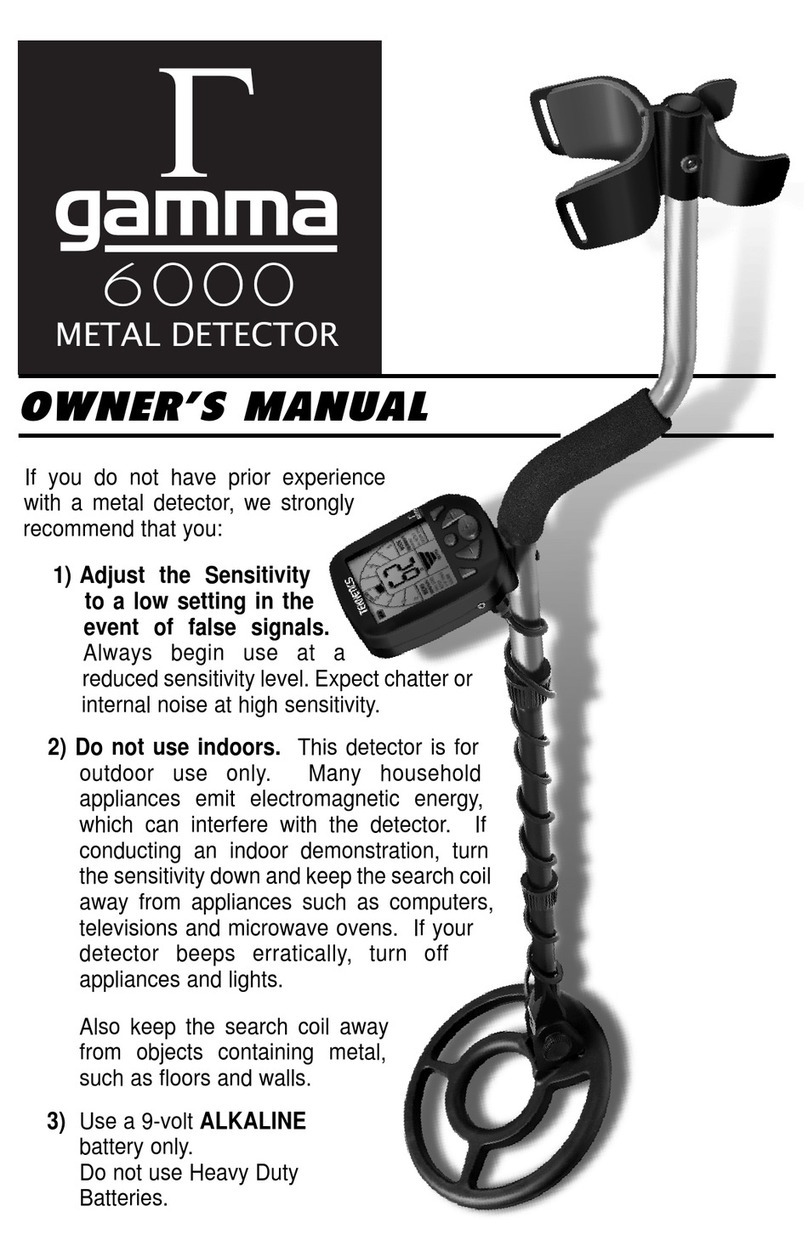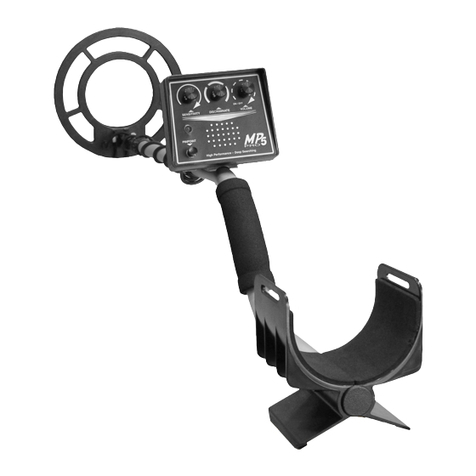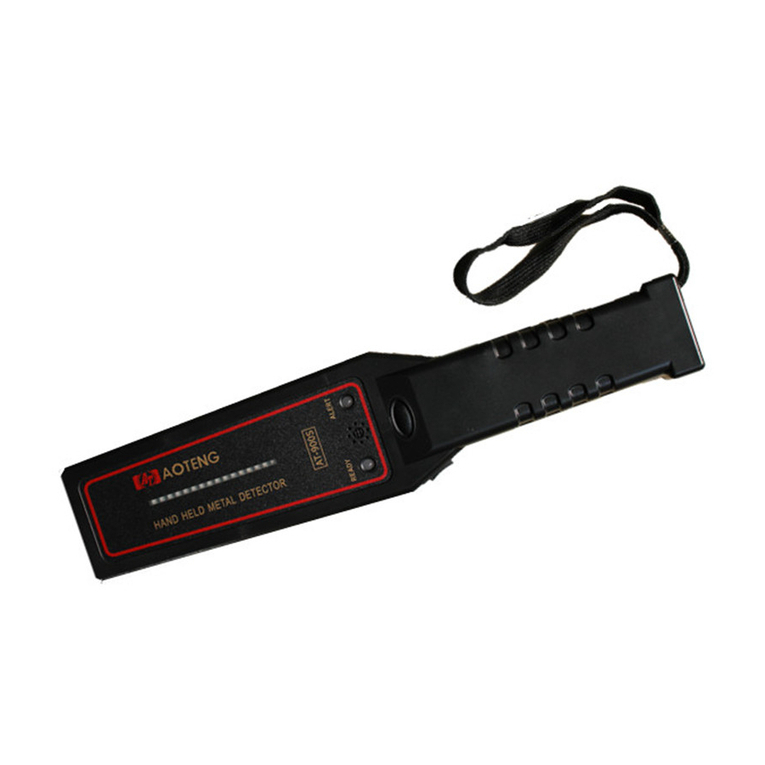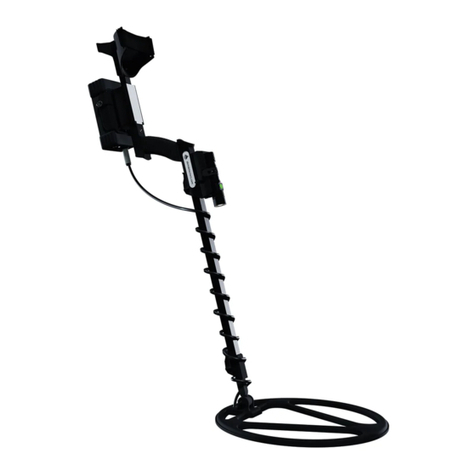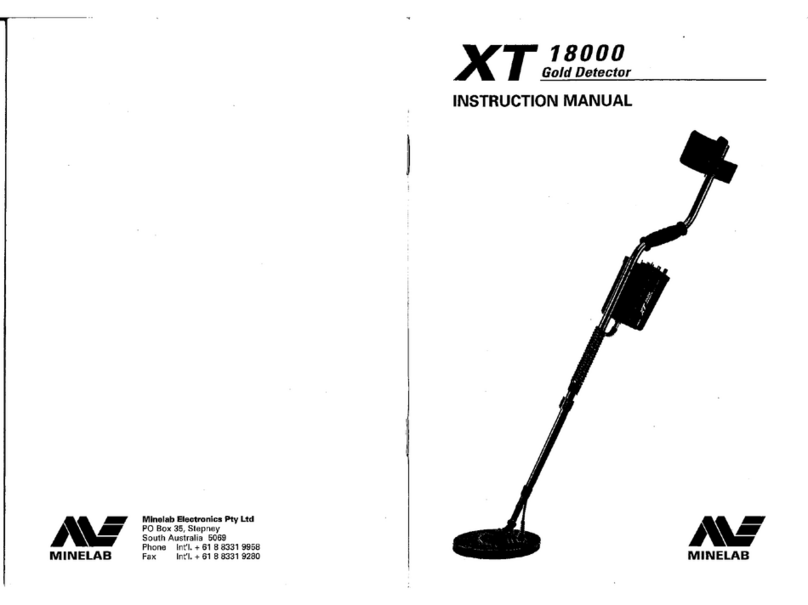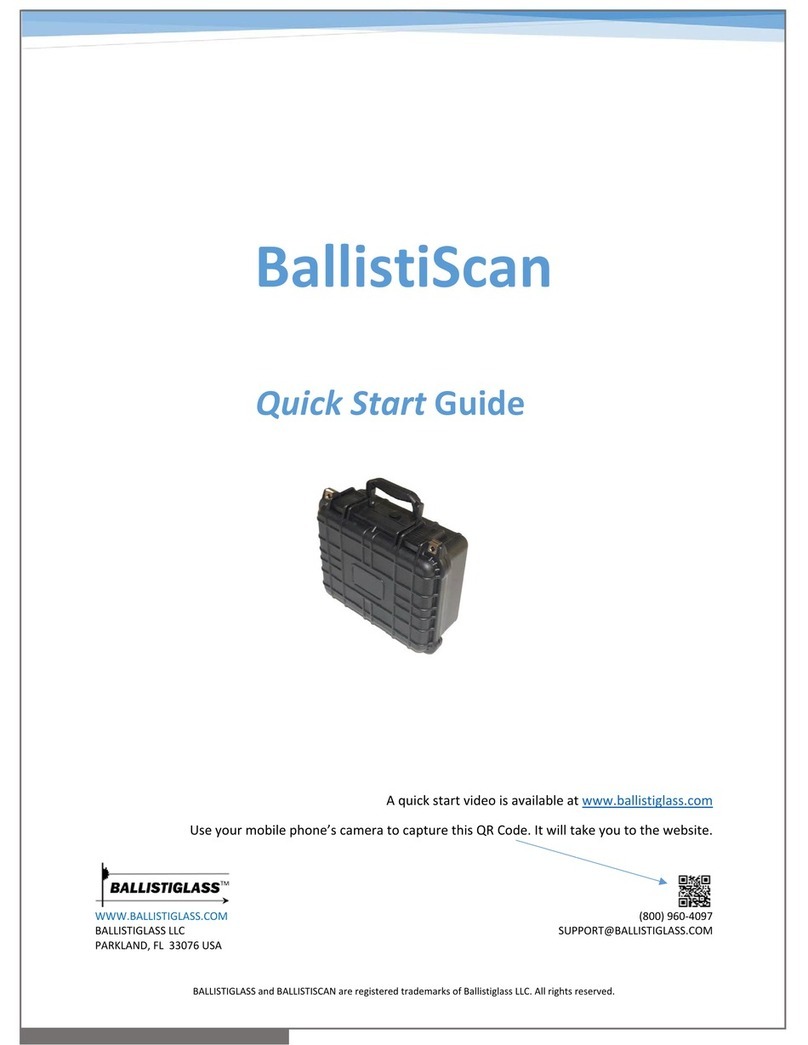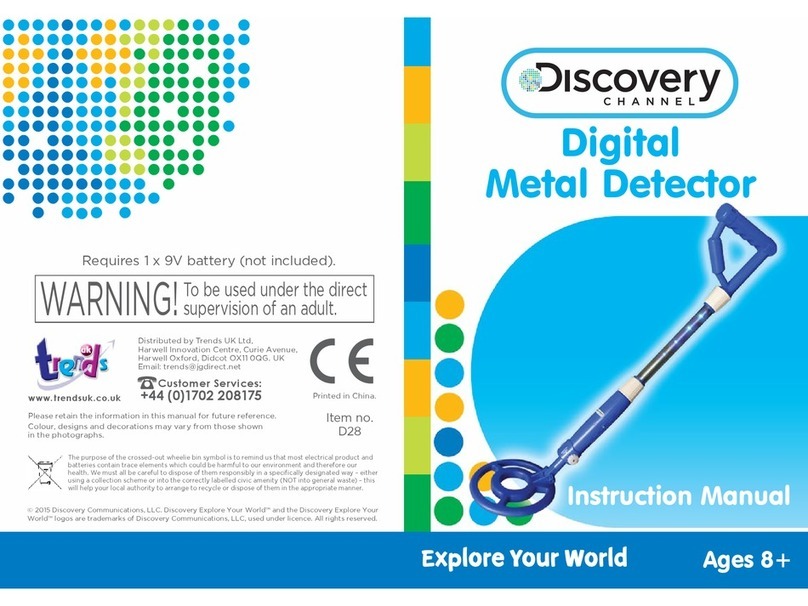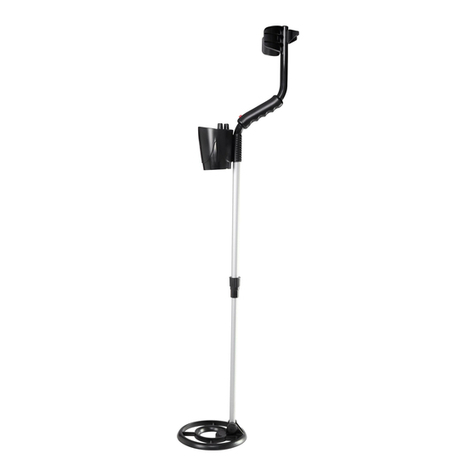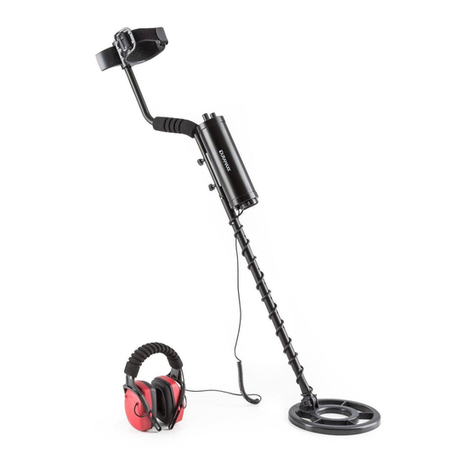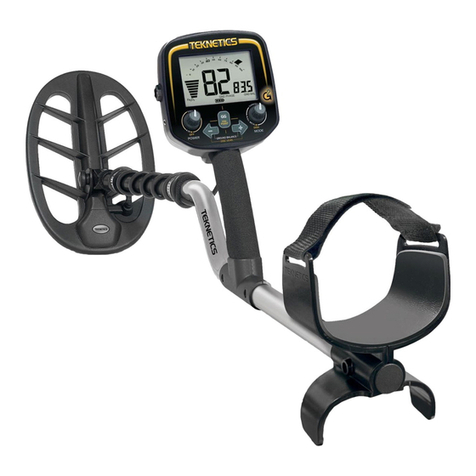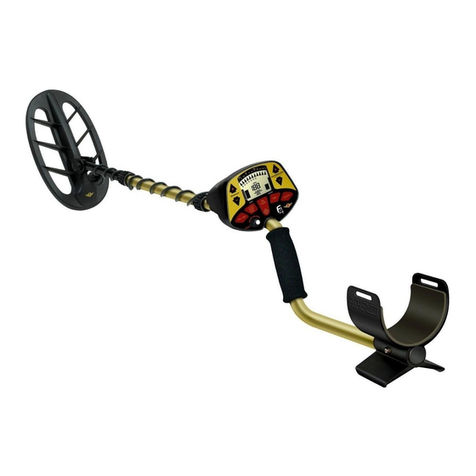First Texas Products Teknetics T2 User manual

Teknetics T2™
Professional Metal Detector
Comprehensive Operating Manual and Guide to Metal Detecting
The Teknetics T2 is a new high-performance multi-purpose professional grade metal
detector. It utilizes the latest advances in electronic technology, and its functional design
represents the leading edge of the metal detector engineering art. The T2 is easier to learn
to use properly than other comparable metal detectors. Its combination of light weight and
balance provides comfort unmatched by any other detector in its price range. Its most
popular uses include coinshooting, relic hunting, and gold prospecting.
PRODUCT FEATURES
* Simple, easy-to-use controls
* Large LCD screen with target identification and operating control displays
* Straightforward menu-driven user interface
* Bar graph readout of ground mineral concentration
* Trigger-actuated FASTGRAB™ground canceling with manual override
* Waterproof 11-inch open-frame BiAxial™ searchcoil
* Single-Filter All Metal mode for maximum detection depth
* Double-Filter Discrimination modes for searching in trashy areas
* Trigger-actuated target pinpointing with variable audio pitch
If you have any questions, or need assistance with your metal detector,
Call 1-800-413-4131, and ask for Teknetics Customer Service.
Revision Level 6.0
Copyright First Texas Product, L.P. March 28, 2006

2
TABLE OF CONTENTS
Quick-Start ……………………………………… 3
Mechanicals
Assembly Instructions ………………………….. 4
Mechanicals………………………………………5
Arm Rest adjustment …………………………… 5
Using Headphones (not included) ……………… 5
Introduction to the Teknetics T2
General information ……..………………………6
Controls…………………..………………………7
Menu System..…………………………………... 8
Ground Cancellation …………………………..9-11
All Metal Mode ………………………….….… 12
Discrimination Mode…………………………13, 14
PinPoint Feature …………………………………15
LCD Visual Display…………………………16 –18
Numeric Target Identification ……………...16
Probable Target Identification……………... 16
Target Depth ………………………………..17
G.C. Phase ………………………………….17
Settings …………………………………......17
Messages ……………………………….......17
Bar Graph ………………………………......18
Battery Indicator ……………………………18
Frequency Shifting ……………………………….18
Capabilities & Limitations…………………...19 - 21
Tips & Techniques
Search Techniques
How to sweep the searchcoil ……………..22
Pinpointing targets ……………………….22
Estimating target size and depth…………. 23
False signals and chatter….……………. 24
Adjusting Sensitivity …………….……….26
Tips on ground canceling …………………27
Detecting Activities
Coinshooting………………………………28
Relic Hunting ….....................................28-29
Gold Prospecting…………………….…29-30
Cache Hunting……………………………..31
Shallow Water Hunting……………………31
How metal detectors work……………………….32
First Texas Products Warranty …………………. 32

3
QUICK START
Start using your T2right out of the box
1. Assemble the detector (see instructions beginning page 4).
2 Install four AA alkaline batteries. All positive terminals point up.
3. Turn the knob, located under the armrest, fully clockwise.
This turns the machine on and sets audio volume to maximum.
4. When first turned on, the T2starts out in the Discrimination mode, with:
Sensitivity preset to 60
Discrimination Level preset to 10
Number of Tones preset to method-1
Sweep the searchcoil from side to side, parallel to the ground. Keep the searchcoil
moving over the ground. If you stop moving the search coil, the sound will also
stop. Probable target type will be indicated at the top of the LCD screen.
5. If the searchcoil is not in motion and not close to metal, the detector should be
silent.
6. If you experience false signals from electrical interference, from the soil itself, or
from lots of trash metal, press the Menu button.
Sensitivity will be highlighted.
Rotate the Settings knob to the left (counterclockwise),
Reduce the sensitivity setting until the false signals go away.
After 5 seconds, the machine will exit the menu and return to
normal operation.
7. Toss a coin on the ground and sweep back and forth over it a few times to get a
feel for how the machine responds.
8. You are now ready to search.
9. Pull the trigger switch with your index finger to pinpoint the exact location of
targets, making them easier to unearth.
When the trigger is pulled, PinPoint is engaged ….
The searchcoil need not be in motion to detect an object.
The 2-digit numeric display indicates approximate target depth, in inches.

4
ASSEMBLY
1. Remove all components from box.
2. Attach searchcoil to lower rod by lining up the holes.
Push coil knob through hole and tighten knob gently.
You will tighten up the coil knob later.
3. Insert smallest rod into upper rod (upper rod holds detector body).
Turntop locking collar counter-clockwise to open up.
Pushinpin on small rod.
Slide small rod into upper rod.
Click pin into hole and tighten locking collar firmly clockwise.
4. Push lower rod into small rod as follows:
Turn locking collar counterclockwise to open up
Push in pin to allow rod to slide in.
Slide lower rod in.
Click pin into any hole.
5. Remove velcro strip from lower rod.
6. Wrap cable around stem as follows:
Leave some slack in cable at base of lower rod.
Secure cable at base of rod with velcro strip.
Wrap cable loosely around entire stem up to bent part of upper rod.
You will re-wrap the cable later after sizing the rods to your height.
7. Push cable into connector on back of housing.
Do not twist the cable or plug. Turn knurled cap nut only.
8. Tighten knurled cap nut by hand to secure cable connection to housing.
Do not twist the cable or plug.
9. Adjust to your height:
Hold detector, standing up, with your arm in the armrest.
Place searchcoil flat on the ground with back edge of coil 6” in front of your
toes.
Click pin on lower rod into nearest hole.
Firmly tighten bottom locking collar to secure lower stem.
10. Attach cable to top of rod with upper Velcro strip
11. Tighten up coil knob to keep searchcoil from flopping.
12. Insert batteries.
The batteries are all installed with the positive terminals pointed upward.
After establishing a comfortable length, firmly tighten the locking collars on the rods to
prevent the tubes from rattling. Rotate the collars a full 270° to engage and lock in place. If
you are unable to rotate a full 270°, use gloves for a better grip.
If the searchcoil appears crooked with respect to the pole, loosen both locking collars and
re-adjust. Hold each of the lower poles in the counterclockwise position as you tighten the
locking collars.

5
MECHANICALS
BATTERIES
The T2uses four AA batteries. Use ALKALINE batteries for best performance.
Rechargeable batteries may be used. Expect 40 hours of service in the field with one set of
ALKALINE batteries.
If you use rechargeable batteries, good-quality NiMH (nickel-metal–hydride) batteries are
recommended. They will usually deliver over 25 hours of service without recharging, but
when they start running low, they die suddenly with little warning.
Always install batteries which are of the same type and the same state of charge.
Otherwise battery life will be determined by the weakest battery, because the good batteries
cannot deliver their power with a dead battery blocking the current.
All 4 batteries are installed with the positive terminals facing upward.
The LCD screen shows battery condition on the right.
ARM REST
The arm rest WIDTH and POSITION are both adjustable.
Arm Rest Width: The sides of the arm rest can be bent inward and outward.
To best stabilize the detector to your arm and body movement, squeeze the sides of
the arm rest around your forearm. For a very secure fit, some users prefer to bend
the arm rest in tightly against the forearm such that you pry the sides loose each
time you place your arm into the arm rest.
Arm Rest Position on Pole: Remove the two bolts to position the arm rest farther forward
or back, to adapt to your arm’s length.
-- To reinsert the bolts, spin and twist them into place. Be careful not to damage
the power cable that runs through the aluminum tube.
-- Insert both bolts completely through both sides of the bracket before attaching
the nut to the opposite side.
-- For maximum stability, the bolts fit very tightly into the holes; you may
have to wiggle each one a bit to push it through the holes.
-- After reinserting the bolts, tighten them very securely. As you swing the
detector from side-to-side, you want the bolts tight enough so that you do not
feel any movement between the pole and arm rest mounting bracket.
If you notice unwanted movement while swinging detector, check the tightness
of the locking collars. The locking collars must be rotated a full 270° to reach the
locking position.
HEADPHONES (not included)
The T2is equipped with a standard ¼-inch stereo headphone jack at the rear of the unit,
located under the elbow as you hold the detector for use. Any headphone with a ¼” stereo
jack should work. Mono headphones will not work.
Using headphones improves battery life, and prevents the sounds from annoying
bystanders. It also allows you to hear subtle changes in the sound more clearly, particularly
if searching in a noisy location.
For safety reasons, do not use headphones near traffic or where other dangers, like
rattlesnakes, are present.

6
Introduction to the Teknetics T2
HIGH PERFORMANCE The Teknetics T2is a multi-purpose high-performance
computerized metal detector. It has the high sensitivity and ground cancellation features
needed for professional gold prospecting, the discrimination responsiveness needed for
serious relic hunting under difficult conditions, and visual target ID considered essential in
searching for coins. The ground cancellation system can be adjusted to allow searching salt
water beaches. The T2operates at 13 kHz for good sensitivity to gold nuggets and jewelry
as well as to coins. The T2 comes with an 11-inch elliptical Bi-Axial searchcoil for
maximum detection depth in mineralized soils.
USER COMFORT The T2is among the lightest and best balanced of all high-
performance metal detectors, so you can hold and swing it almost effortlessly. The arm
rest position is adjustable to fit your arm. The grip is durable high-friction foam elastomer,
comfortable in any kind of weather. The controls are conveniently located and easy to
learn how to use. Locking collars on the tubes eliminate rattling.
EASY-TO-USE & INFORMATIVE INTERFACE The entire menu is always visible on
the LCD display. The LCD display indicates the electrical signature (target I.D.) of the
detected metal object. The display provides continuous information on battery condition
and on ground mineralization, which affects detection depth. Help messages are
automatically displayed on the lower right corner of the display when necessary.
LOW OPERATING COST The T2is powered by four AA alkaline batteries, which will
typically last for more than 40 hours of use before needing replacement.
DESIGNED BY EXPERIENCED ENGINEERS The lead engineers on the T2 design team
were John Gardiner, firmware engineer, and David Johnson, whose expertise is behind
many of the best-known high-performance metal detectors offered by major U.S.
manufacturers for the last 24 years.

7
CONTROLS
ON-OFF & VOLUME Knob (Under the elbow)
This knob turns the machine on or off, and controls speaker volume and headphone
volume. Knob position has no effect on detector’s sensitivity or susceptibility to noise
from electrical interference
The T2has two controls on the front panel, MENU and SETTINGS.
MENU Pushbutton (On right of the front panel)
Push the MENU button to:
1. Step through the menu selections on the display.
With each push of the button, the next menu selection will be highlighted.
The SETTINGS knob allows you to change values for the highlighted selection.
2. Recall the last setting which you adjusted.
After you have adjusted a setting, an arrow will remain highlighted next to this
menu selection. One push of the button will recall that selection and display the
stored value.
This recall function is useful for a value you want to adjust frequently, such as the
ground cancellation value.
SETTINGS Knob (On the left of the front panel)
Rotate the SETTINGS knob to:
1. Change the setting (or value) of the highlighted menu selection you have chosen.
2. Select operating MODE when the top line of the menu is highlighted.
When used to switch back and forth between the All Metal mode and
Discrimination mode, the detector changes modes as soon as the corresponding
selection is highlighted. The All Metal mode is used to detect all metal objects,
including small or deep objects. Use the Discrimination mode to ignore trash metal
such as nails, foil, or pull-tabs.
3. Recall the last setting which you adjusted.
When you rotate the knob, you are also changing the value. If using this knob to
recall a setting, it is best to rotate just one indent.
TRIGGER SWITCH (Under the display in front of your hand)
While the trigger is pulled back, metal objects are temporarily detected without the need
for searchcoil motion. This aids in pinpointing the exact location of objects which were
found while searching in the All Metal or Discrimination Mode.
When the trigger is pushed forward, FASTGRAB automatic ground cancellation is
activated. The internal computer measures the magnetic properties of the soil in order to
cancel interference from naturally-occurring minerals in the ground. After the detector
measures the soil in this manner, the detector then uses this information to control
operation in both the All Metal and Discrimination search modes.

8
THE MENU SYSTEM
The entire menu is printed on the LCD display. The display highlights the mode and
settings which are in use.
There are two search modes, All Metal and Discrimination. To change between search
modes, the top line of the menu system must be highlighted. Press the MENU button until
the top line of the menu is highlighted. When either All Metal or Discrimination is
highlighted, rotate the SETTINGS knob to change between the two modes.
Each search mode has three adjustable function settings:
ALL METAL: Sensitivity, Hum Level, and Manual Ground Cancellation.
See page 12.
DISCRIMINATION: Sensitivity, Discrimination Level, and Number of Tones.
See page 13.
To select a function, push the MENU button and continue pushing to move to the function
you want. The word SETTING will pop up on the display above the menu, and the
present setting of that function will be displayed as a number.
To change a setting, rotate the knob.
To increase a value, rotate to the right (clockwise)
To decrease a value, rotate to the left (counterclockwise)
If you select a function and do not make a change to that function after 5 seconds, the
detector will exit the menu system automatically, and resume normal operation.
If you press the MENU button or rotate the SETTINGS knob while the machine is in
normal operation, the user interface will return to the last menu feature setting. This
feature allows you to have quick access to a function that you want to adjust frequently.

9
GROUND CANCELLATION
What is Ground Cancellation?
All soils contain minerals. Signals from ground minerals are often tens or hundreds of
times as strong as the signal from a buried metal object. The magnetism of iron minerals,
found in nearly all soils, causes one type of interfering signal. Dissolved mineral salts,
found in some soils, are electrically conductive, causing another type of interfering signal.
Ground Cancellation is the process by which the metal detector cancels the unwanted
ground signals while leaving signals from buried metal objects intact. This is accomplished
by establishing the detector’s internal Ground Phase setting; this setting is calibrated to the
soil and eliminates the ground minerals’ signal.
When the detector is calibrated to the actual soil condition, the result will be deeper target
detection, quieter operation, and more accurate target identification. This calibration, or
Ground Cancellation, can be accomplished automatically with the detector’s internal
computer, by pushing the Trigger Switch forward, or manually in the All Metal menu.
The ground cancellation setting carries through into both All Metal and Discrimination
modes. In Discrimination mode, the ground signal is generally inaudible unless the
discrimination setting is 0.
AUTOMATIC GROUND CANCELLATION PROCEDURE (FASTGRABTM)
1. Find a spot of ground where there is no metal present.
2. Hold the detector with the searchcoil about one foot above the ground.
3. Push the TRIGGER SWITCH forward with your index finger.
4. Physically pump the searchcoil and detector up and down over the ground.
Lift it about 6 inches above the ground and lower it to within 1 inch of the
ground, about once or twice a second.
5. A 2-digit value will appear on the display. This is the Ground Phase setting.
If the detector’s internal computer is unable to cancel the ground signal, the
message CAN’T GC will appear; find another spot of ground and try again.
MANUAL GROUND CANCELLATION
In most situations, it is preferable to push the trigger switch to activate FASTGRAB
automatic ground cancellation. Generally, it is best to first let the computer automatically
cancel interference from ground minerals. However, for gold prospecting, searching on a
wet saltwater beach, or searching in an area with so much metal trash that there is no clean
ground for the computer to sample, we recommended that you cancel ground manually.
Manual ground cancellation requires a bit of skill, acquired with some practice.
The range of ground cancellation settings indicated on the display range from 0 to 99;
however, each displayed number spans 5 detent steps on the settings knob. The actual
internal ground cancellation setting changes with each step; there are a total of 500
different settings. Under some ground conditions you may be able to hear the individual
steps in the setting.

10
GROUND CANCELLATION (continued)
MANUAL GROUND CANCELLATION (continued)
The Fe3O4bar graph on the LCD display indicates the amount of magnetic mineralization.
The searchcoil must be in motion to measure Fe3O4. The most accurate measurement is
obtained by pumping the searchcoil, as in the Ground Cancellation procedure.
The two-digit G.C. Phase number displayed on the LCD indicates the type of ground
mineralization.
Some typical ground mineralization types are:
0 – 10 Wet salt and alkali
5 – 25 Metallic iron
26 – 39 Very few soils in this range -- occasionally some saltwater beaches
40 – 75 Red, yellow, and brown iron-bearing clay minerals
75 – 95 Magnetite and other black iron minerals
When manually ground canceling, try to “feel out” a spot on the ground to make sure there
is no metal present. In order to avoid locking onto metal, the computer will not cancel
ground where the numbers are less than 40. Where the ground reads less than 40, manual
ground cancellation is required.
To perform the Manual Ground Cancellation operation, do the following:
1. Select the MANUAL G.C. function
The legend G.C. PHASE appears.
The present ground cancellation setting is displayed (0-99).
The message PUMP COIL TO G.C. will appear.
2. Physically pump the searchcoil and detector up and down over the ground.
Lift it about 6 inches above the ground and lower it to within 1 inch
of the ground, about once or twice a second.
3. Turn the SETTINGS KNOB to adjust the level.
The goal is to eliminate the sound as the coil is being pumped over the
ground. In some soils, the sound is not completely eliminated; rather, the
audio feedback is the same both when lowering the searchcoil to the ground,
and when lifting the searchcoil off of the ground.
If the ground cancellation adjustment is incorrect, there will be a difference in the sound as
the searchcoil is either moving toward or away from the ground. It sounds like you are
either pulling the sound out of the ground, or pushing the sound into the ground.
-If the sound is louder as you raise the searchcoil, increase the ground
cancellation setting.
-If the sound is louder as you lower the searchcoil, reduce the ground
cancellation setting.
-NOTE: Experienced users often prefer to adjust the ground cancellation to
get a weak but audible response when lowering the searchcoil. This is
called adjusting for positive response.

11
GROUND CANCELLATION (continued)
Positive and Negative Response
The purpose of ground cancellation is to adjust the metal detector to ignore ground
minerals. If the adjustment setting is off, ground minerals will give either a positive or
negative response, depending on which direction the adjustment is off.
POSITIVE RESPONSE
If the G.C. setting is too high a number, the response of minerals will be positive. This
means that when the searchcoil is lowered to the ground in PinPoint or All Metals mode,
the sound will get louder as the searchcoil approaches the ground. The sound will grow
quieter as the searchcoil is raised. What, if anything, you hear in discrimination mode
depends on the discrimination setting.
When searching in All Metals mode, if ground cancellation is properly set to cancel the
ground, and you sweep over a positive hot rock, the rock will give a “zip” sound similar to
that of a metal object.
NEGATIVE RESPONSE
If the G.C. setting is too low a number, the response of minerals will be negative. When
the searchcoil is lowered to the ground in PinPoint or in All Metals mode, the machine will
be silent. In All Metals mode, the machine will sound off as the searchcoil is lifted away
from the ground. What, if anything, you hear in discrimination model depends on the
discrimination setting.
When searching in All Metals mode, a negative hot rock will produce a “boing” sound after
passing over it, making it difficult to understand where it is located. It will not have the
sound and “feel” of a metal object.

12
ALL METAL MODE
The All Metal mode is more sensitive and offers better feel than the Discrimination mode,
and is used to find all metal objects present in the ground. The searchcoil must be in
motion for objects to be detected. This is a single filter search mode similar to the “fast
autotune”, “SAT”, or “P4” mode found in other detectors you might already be familiar
with.
SENSITIVITY This controls the electronic gain, and is adjustable from 1 to 99. In the
presence of electrical interference, high ground mineralization, or variable ground
mineralization, operation will usually be too noisy (wobbly and erratic sound from the
speaker) if the sensitivity is set too high. At settings above 90, the internal circuit noise of
the machine will probably be audible. The sensitivity level setting is largely a matter of
personal preference. However, if you cannot hear at least some noise, the smallest or
deepest objects will not be detected.
HUM LEVEL This is the same thing that some manufacturers call audio threshold. It is
adjustable from -9 to +9. For maximum ability to hear the weakest signals, adjust this
background hum level high enough so that it is barely audible while the detector is in use in
the field. To eliminate the weakest signals, adjust the hum level into the negative region,
which will allow the machine to run silently if the Sensitivity is not set too high.
The hum level changes slightly with each detent step on the Settings knob. Each number
on the hum level numeric readout corresponds to five steps.
MANUAL GROUND CANCELLATION
Manual Ground Cancellation can only be performed while in the All Metal mode, but the
resultant setting will carry over if you change into Discrimination mode. See the previous
section on Ground Cancellation for instructions on how to use this feature.

13
DISCRIMINATION MODE
The Discrimination Mode is used to eliminate from detection trash metal objects such as
nails, aluminum foil, or pull-tabs. The searchcoil must be in motion for metal objects to be
detected. Discrimination incurs some loss of sensitivity to small or deep objects.
SENSITIVITY
This controls the electronic gain, and is adjustable from 1 to 99. Unlike the All Metal
mode, the Discrimination mode is designed to operate silently. If you hear noise when there
is no metal present or when the searchcoil is not in motion, reduce the Sensitivity setting
until the machine goes quiet. NOTE: there is no interaction between the sensitivity
settings of the All Metal and Discrimination Modes.
DISCRIMINATION LEVEL
This is adjustable from 0 to 80, and controls the range of objects to be silenced
(discriminated out or rejected). Objects with numeric values below the selected
discrimination level will not be detected. NOTE: the numerical range that pertains to each
class of object is printed at the top of the visual display. To eliminate iron, a setting of 40
is usually about right. A setting of 80 will eliminate aluminum trash and zinc pennies, but
nickels will also be lost.
NUMBER OF TONES (# OF TONES)
This menu selection offers the user a choice among several different methods of audio
discrimination to accommodate a variety of search conditions and personal preferences.
These methods differ in the way the signals are processed for analysis, and in the number
of audio tones used to identify different target types.
The detector has two ways of processing signals for analysis -- continuous and sampled.
Continuous Processing
The detector processes a continuous signal response throughout the duration of the sweep
of the searchcoil over the target. All characteristics of the target are audibly communicated
to the user. Continuous processing gives a good feel for the size, depth, and shape of the
target. Continuous processing is preferred, for example, for relic hunting, especially in
plowed or rocky ground.
Sampled Processing
Sampling takes a snapshot of the signal at its strongest point. This compromises the feel of
a continuous response, but provides for more accurate target identification. Sampling also
eliminates confusion caused by changes in tones during the sweep over the target.
Sampling is preferred, for example, when coinshooting in areas where there is aluminum
trash.

14
DISCRIMINATION MODE (continued)
The “# OF TONES” selections are:
1 Single Medium pitch tone.
Discrimination is continuous, not sampled. Good for use in plowed or rocky ground.
1+Medium-to-High pitch tone varying in proportion to target signal strength.
Large shallow objects will produce a squeal. The variable audio pitch provides you more
information about the detected object, but some people find the sound on strong signals too
annoying. Good for use in plowed or rocky ground.
2+ Two tones.
Similar to 1+, except that iron produces a low-pitched tone regardless signal strength. The
discriminator is continuous. However, the iron tone feature relies on a combination of
continuous and sampled processing. Useful if you want to hear all targets.
3 Three different audio tones. Iron produces a low pitched tone. Aluminum trash and zinc
pennies produce a medium tone. Most other coins, including nickels, produce a high tone.
A combination of continuous and sampled processing reduces the breaking up of the tone
due to deep objects, or multiple objects close together. This method is usually preferred if
you are searching for coins in a trashy area. Most users will set the discrimination level
below nickels, at about 50, and dig only objects that produce a consistent and repeatable
high tone. NOTE: with this method, some steel bottle caps produce consistent high tones,
similar to coins.
3b Bottle Cap Mode Similar to 3, but modified so that steel bottle caps will usually produce
inconsistent, or non-repeatable, tones and broken sounds. There may be a slight reduction
in the ability to separate adjacent targets. Use this method in areas with a high
concentration of steel bottle caps. Also refer to p. 21 for sweep techniques to aid in the
identification of steel bottle caps.
4Four different audio tones This method is similar to 3, but with a fourth medium-high
tone for targets in the numeric range of 73 to 79. This four-tone system is useful for
searching in areas where there may be very old coins which register in this range.
dP Delta Pitch This method produces a tone whose pitch varies in relation to the visual ID
number -- the higher the ID, the higher the pitch. Good for relic hunting. Sampling is
mostly continuous. This method is also useful in areas with a high concentration of steel
bottle caps. Coins will produce a fairly constant pitch as you sweep back and forth. Bottle
caps produce inconsistent tones, often with a squawk at the beginning of the sound.
What You See vs. What You Hear
The visual target ID displayed on the LCD is based entirely on sampled processing; the
number displayed represents the snapshot. When using these different “# OF TONES”
methods, the detector’s audible response may differ from the visual. Using these methods,
there is not a 100% correspondence between what you see and what you hear, especially on
buried targets where ground minerals influence target ID and audible response. By making
the audio and visual systems independent, the T2allows each system to do what it does
best. The audio is optimized for quick response and target feel, whereas the visual system
provides the best numeric resolution of target ID.

15
PinPoint Feature
After a buried target has been located using the All Metal or Discrimination modes, you
want to pinpoint the exact location of the target in order to facilitate its recovery. Accurate
target pinpointing will minimize digging.
Activate the PinPoint feature by pulling the trigger switch located under the housing, in
front of the grip. Unlike the All Metal and Discrimination modes, PinPoint does not
require motion to detect metal. PinPoint will detect objects while the coil is in motion and
will continue to detect metal if searchcoil motion stops over the target.
Ground Pick-Up
If you have not performed the ground cancellation procedure, the PinPoint feature usually
causes the ground to sound off. This means that while pulling the pinpoint trigger, the
audio tone will get louder as you lower the searchcoil to the ground; this is called ground
pick-up. Since you want to hear the target, rather than the ground, we recommend first
ground canceling in order to eliminate ground pick-up. Alternatively, if you experience
ground pick-up, you may place the coil very close to the ground, off to the side of the
target; then pull the trigger, and raise the searchcoil slightly while passing it over the target.
How to Pinpoint
Position the searchcoil just barely off the ground, and to the side of the target. Then pull
the trigger, and raise the searchcoil about 2 inches. Lifting the searchcoil away from the
ground causes the ground signal to go negative; the machine becomes silent. Now move
the searchcoil slowly across the target, and the sound will communicate the target’s
location. As you sweep from side to side, and hear no sound at the ends of the sweep, the
target is located in the middle of that zone, where the sound is loudest and the audio pitch is
highest. If the sound is loud over a wide area, the buried object is large. Use the PinPoint
feature to trace an outline of such large objects.
Narrow It Down
To further narrow the field of detection, position the searchcoil near the center of
the response pattern (but not at the exact center), release the trigger, and then pull it
again. Now you will only hear a response when the searchcoil is right over the top
of the target. Repeat this procedure to narrow the zone even further. Each time you
repeat the procedure, the field of detection will narrow further.
Controlling Sensitivity in PinPoint mode
The default sensitivity setting in PinPoint is 60. If you wish to change the PinPoint
sensitivity setting:
1) Pull the trigger to engage PinPoint. Do not release the trigger.
2) Rotate the SETTINGS knob to change the sensitivity.
Rotate counterclockwise to decrease sensitivity; clockwise to increase.
Adjustment to PinPoint sensitivity will not affect sensitivity of the All Metal or
Discrimination modes. Likewise, sensitivity changes in the other modes will not affect
Pinpoint. Changes to pinpoint sensitivity will be saved after the trigger is released. When
the T2 is powered off, the device will revert to the default setting.

16
LCD VISUAL DISPLAY
In normal operation, when the searchcoil passes over a metal object, the electrical signature
(2-digit I.D.) of the metal object is displayed on the numeric display for 4 seconds, unless
superceded by another object sooner. On a given buried object, the number will bounce
around if the signal is weak or if the amount of ground mineralization is high.
At the top of the display, an arrow indicates the classification of the object.
NUMERIC TARGET I.D. (2-digits)
The following table shows the numbers typically associated with certain commonly
encountered nonferrous metal objects. Older silver U.S. coins usually read about the same
as their modern clad equivalents. Modern quarter-sized dollar coins like the Susan B.
Anthony and the Sacagawea read about the same as a quarter. Many Canadian coins are
minted from a magnetic nickel alloy which gives very inconsistent readings and may
register as iron. Most one-ounce silver bullion coins will fall into the same range as the
modern U.S. $1 Eagle.
OBJECT TARGET I.D.
foil from gum wrapper 40 - 55
U.S. nickel (5¢ coin) typically 58
aluminum pull-tab 60 - 75
aluminum screwcap 70 - 80
zinc penny (dated after 1982) typically 78
aluminum soda pop can 75 - 85
copper penny, clad dime typically 83
U.S. quarter (25¢ coin), clad typically 89
50¢ coin, modern clad typically 92
old silver dollar coin typically 94
US silver Eagle $1 coin typically 95
PROBABLE TARGET I.D.
The probable target ID zones at the top of the LCD display represent the signal ranges
produced by various coins and types of metal objects. When a metal target is detected, the
microcomputer analyzes the signal and categorizes it based on what kinds of metal objects
usually produce that kind of signal. The microprocessor then displays an arrow along the
top of the LCD screen above the icon which represents that category.
For instance, if the detected signal fits within the parameters usually exhibited by zinc
pennies and the electrically similar aluminum screwcaps, the microcomputer will
categorize the signal as "zinc penny/aluminum screwcap". The LCD screen will then
illuminate the arrow above the zinc/screwcap icon.
Copper pennies (pre-1982) will usually register in the 10¢ zone.
Most gold jewelry is small, and will tend to read in the 40-60 range. Silver jewelry usually
has more metal in it and therefore tends to produce higher readings.

17
LCD VISUAL DISPLAY (continued)
Since different metal objects can produce similar signals, and since minerals in the soil can
distort the signals, the probable target ID's are just that -- probable. There is no way of
knowing for sure what's buried other than to dig it up. Experienced metal detector users
have a rule of thumb -- "when in doubt, dig".
The target indicator arrows are coded for signal strength -- bold arrow for strong signals,
caret (^) arrow for medium signals, and small triangle for weak signals. When sweeping
back and forth to check a target, the indications corresponding to the strongest signals will
usually be the most accurate.
TARGET DEPTH
When the trigger is pulled to facilitate pinpointing an object, the numerical display
indicates the approximate depth of the object, in inches, based on the assumption that the
object is a typical US coin. Small objects will read deeper than they actually are, and large
objects will usually read shallower than they actually are.
G.C. PHASE
This is the ground cancellation setting, 0-99. It is displayed when in the Manual G.C.
menu setting, and when the trigger is pushed for FASTGRAB computer-assisted ground
cancellation.
SETTING
This is illuminated when you are in the menu. When the word “SETTING” is indicated,
the number being displayed is a setting, and not, for instance, a Target ID indication.
MESSAGES
If a metal object or highly magnetic soil is so close to the searchcoil that the signal is
overloading the circuit, the message OVERLOAD - RAISE COIL will appear.
Such overloads will not harm the detector, but the detector will not detect metals properly
under these conditions. Raise the coil until the message disappears; the siren sound will
also stop. Resume normal detection.
The message RAISE COIL only appears when using the 3b or dP methods, accessed
through # OF TONES menu selection. This message indicates the presence of a target
which may be too close to the searchcoil to be accurately identified. For better target
identification, sweep the searchcoil farther away from the surface of the ground.
The message PUMP COIL TO GC will appear when you push the trigger forward to
ground cancel. See the Manual Ground Cancellation section of this manual for
instructions.
The message CAN’T GC can only appear when the trigger is pushed forward, invoking
FASTGRAB automatic ground cancellation. This message appears when the detector is
unable to measure the soil in a manner suitable for ground canceling. This message is
usually the result of the presence of metal. Try another spot to find an area free of metal.

18
LCD VISUAL DISPLAY (continued)
BAR GRAPHS Fe3O4(magnetite)
This bar graph displays the magnetic mineralization factor, or magnetic susceptibility, of
the soil. Magnetic susceptibility is expressed in terms of the percent volume of the iron
mineral magnetite, which most black sand is made of. The depth to which objects can be
accurately identified is strongly influenced by the magnetic susceptibility of the soil. High
Fe3O4values have a greater effect on detection depth in the Discrimination mode than in
the All Metal mode. For the most accurate Fe3O4 reading, pump the searchcoil as though
you were ground canceling.
Fe3O4approx.
Range micro-cgs Description
3 7,500 uncommon but not rare, heavy mineralization
1 2,500 heavy mineralization, not uncommon in goldfields
0.3 750 heavy mineralization, but not uncommon in some regions
0.1 250 medium mineralization, typical
0.03 75 light mineralization, but common
0.01 25 light mineralization, often low G.C. setting
blank <14 quartz & coral white beach sands
BATTERY CONDITION INDICATOR
Fresh alkaline batteries will illuminate all four bars. When no bars are displayed and the
batteries are about to go dead, the BATT legend will start flashing. If using NiMH
rechargeable batteries, the display will remain stuck on the second or third bar for most of
the battery life; when it drops to the first bar, the batteries will go dead within several
minutes.
FREQUENCY SHIFTING
One disadvantage of a highly sensitive metal detector is its susceptibility to electrical
interference from other electronic devices. If the detector chatters while the searchcoil is
not in motion, the cause is either electrical interference or internal circuit noise due to a
high sensitivity setting. If the detector chatters or emits intermittent false signals in the
field, you are also probably experiencing electrical interference. If you suspect electrical
interference, you may change the T2’s operating frequency. This is a trial and error method
to try to find a frequency different from the suspected source.
To shift frequencies:
1. Hold the MENU button down. Do not release the button.
2. Push the trigger forward to increase the frequency
Or pull the trigger back to decrease the frequency.
Each frequency change requires a push of the MENU button.
Each actuation will shift the frequency by one value.
The LCD will display the frequency, from F1 to F7. The default frequency is F4. The T2
will default back to F4 when the power is switched off.
See page 24 for more information on electrical interference.

19
CAPABILITIES AND LIMITATIONS
DEPTH
The T2can detect U.S. coins to a depth of about 12-15 inches under good conditions. Large
objects (55 gallon drums, manhole covers, etc.) can be detected to a depth of several feet.
Electrical interference from power lines and from electrical appliances and electronic
equipment can reduce detection depth, or cause audible interference, making it necessary
for the user to reduce the sensitivity setting. Soils with large amounts of iron or salt
minerals may also reduce detection depth or necessitate a reduction in the sensitivity
setting.
TARGET IDENTIFICATION
The T2identifies the probable type of metal object by measuring its effective electrical
conductivity, which is displayed as a number from 0 to 99 on the LCD screen. The
effective electrical conductivity of an object depends on its metallic composition, size,
shape, and orientation relative to the searchcoil. Since coins are minted to tightly
controlled specifications, they can be accurately identified. Identification of pull-tabs and
foil is less consistent because these kinds of targets come in wide variety. In general,
smaller objects, and objects made from lower conductivity alloys such as iron, bronze,
brass, lead, pewter, and zinc will read lower on the effective conductivity scale. Larger
objects and objects made from higher conductivity alloys such as silver, copper, and
aluminum, will tend to read higher. The notable exceptions are gold, which usually reads
low because it is rarely found in large pieces, and zinc pennies, which read moderately high
because of their size and shape. Although nails and other iron and steel objects will usually
give low readings, ring-shaped pieces of iron (for instance steel washers and harness rings)
will usually produce medium to high readings. Flat pieces of iron or steel, such as can lids,
will occasionally do the same.
Most targets can be identified accurately in air to a distance of about 10 inches. The
minerals in many soils will cause identification to be less accurate. In most soils, effective
target identification can be had to a depth of at least 8 inches.
REQUIREMENT FOR MOTION; PINPOINT FEATURE
As with other modern metal detectors, the T2’s searchcoil must be kept in motion in order
to both detect and identify targets. The All Metal mode is more forgiving of sweep speed
variation than is the Discrimination mode.
The trigger-activated PinPoint feature continues to detect metal if searchcoil motion stops
over the target. The PinPoint feature is used primarily to pinpoint the exact location of a
target so that it can be retrieved with a minimum of digging, and does not provide target
identification.

20
CAPABILITIES AND LIMITATIONS (continued)
GROUND CANCELING
To achieve maximum depth in both the ALL METAL and DISCRIMINATION modes, as
well as when using the PinPoint feature, the T2offers the ability to cancel ground minerals
either by manual adjustment, or automatically using the FASTGRAB feature (see p.9).
If you do not perform the ground canceling operation, the Discrimination mode will usually
still work fairly well, but the ALL METAL mode will not. The Pinpoint feature can be
used for pinpointing objects at moderate depth in most soils without prior ground-
canceling.
The internal computer will not cancel salt water, so when detecting on wet ocean beaches,
ground cancellation must be done manually.
DISCRIMINATION
Discrimination refers to a metal detector's ability to ignore metal objects in selected
categories, especially iron and aluminum. This makes searching much more pleasant in an
area with a lot of metal trash. The T2offers a wide variety of discrimination features which
you can select according to the search conditions and your personal preference.
DEPTH READING
The estimated Depth Reading displayed when engaging the PinPoint feature is based on the
strength of the signal. It is calibrated for typical coin-sized objects. Small objects will read
deeper than they actually are, and large objects will read shallower than they actually are.
AIR TESTING
There may be times when you want to test or demonstrate the metal detector without
sweeping it over the ground, for instance, if not fully assembled, or if you are indoors. To
air test, place the searchcoil in a spot where the detector is stable and more than two feet
away from any large masses of metal, including the reinforcing steel usually present in
concrete. If you are wearing a wristwatch or jewelry on your hand or arm, remove it.
Then, test or demonstrate by waving metal objects over the searchcoil; wave objects
briskly, several inches over the top of, and parallel to, the searchcoil.
Ground cancellation cannot be tested or demonstrated in air unless you happen to have
appropriate specimens of iron minerals available.
SWEEP SPEED
The T2is noted for its quick response. This gives it unsurpassed ability to locate and
identify good targets surrounded by trash. It also permits the user to sweep the searchcoil
quickly in order to cover more ground with very little risk of losing targets. In general, if
you are searching an area where the desirable targets are more than 8 to 10 inches deep, a
faster sweep speed will detect to a greater depth and yield more accurate target IDs.
CHECKING A TARGET
In order to most accurately verify a detected target with most other metal detectors, users
will narrow their sweep and loiter over the top of the target. The T2is different. The T2's
quick response and advanced signal sampling system produces the most accurate target IDs
with deliberate sweeps all the way across the target, even if there are other targets nearby.
If you loiter over targets to check them with the T2, the ID's will bounce around more and
you run the risk of misidentifying the target.
Other manuals for Teknetics T2
1
Table of contents
Other First Texas Products Metal Detector manuals
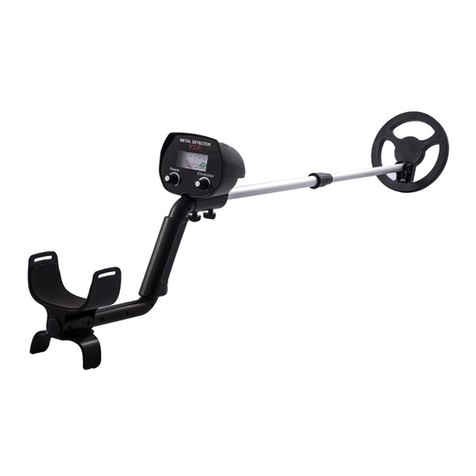
First Texas Products
First Texas Products VLF 2.1 User manual

First Texas Products
First Texas Products Cabelas Platinum User manual

First Texas Products
First Texas Products Teknetics T2 User manual

First Texas Products
First Texas Products titanumCamo User manual
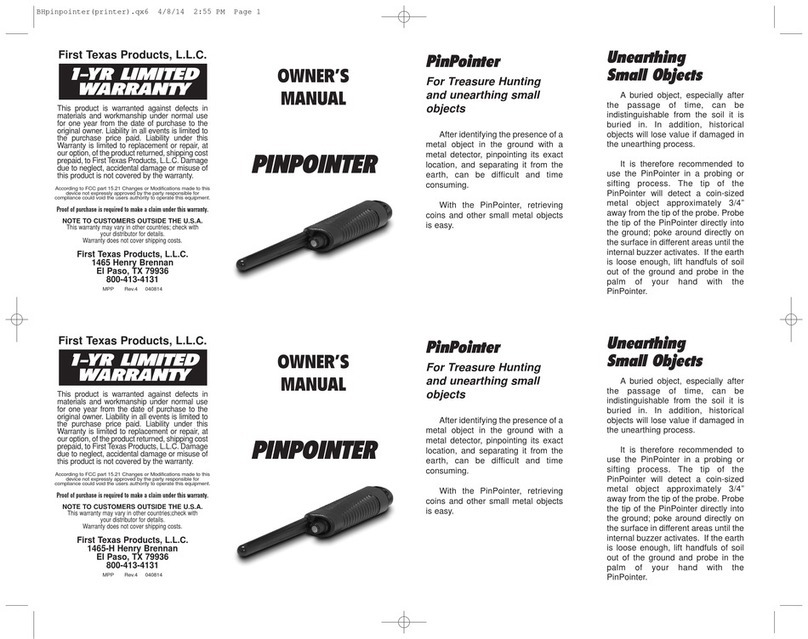
First Texas Products
First Texas Products PINPOINTER User manual

First Texas Products
First Texas Products Titanium Camo User manual

First Texas Products
First Texas Products GOLD DIGGER User manual
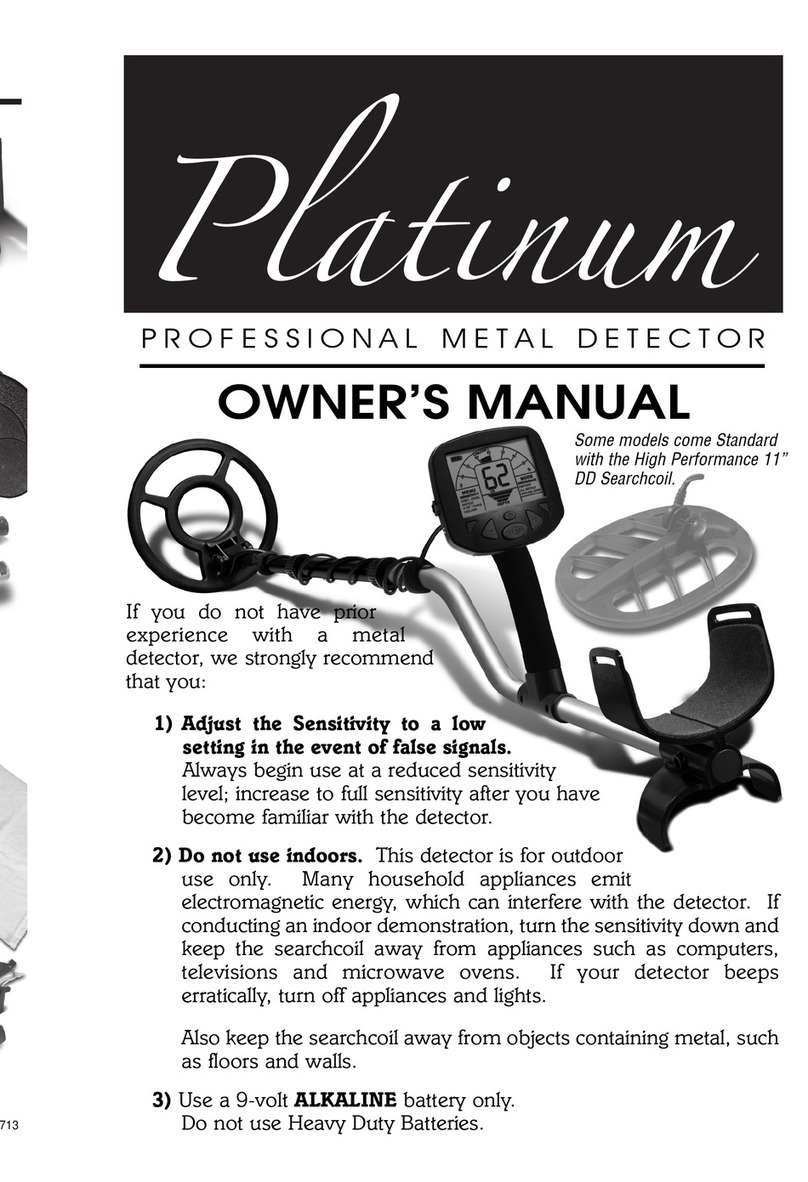
First Texas Products
First Texas Products Platinum User manual

First Texas Products
First Texas Products PinPointer User manual
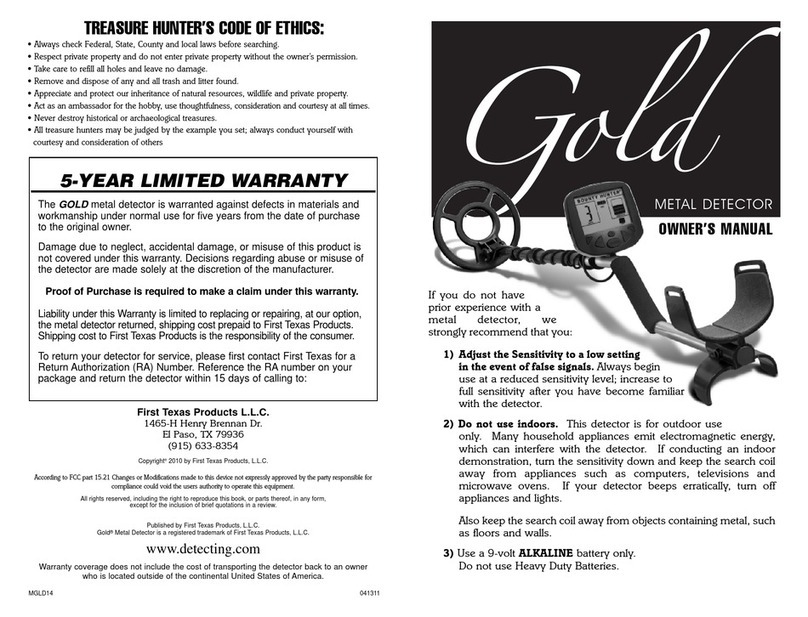
First Texas Products
First Texas Products Gold User manual
